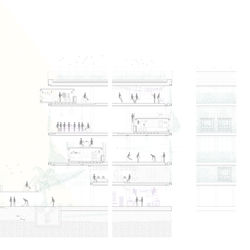 |  |  |
|---|---|---|
 |  |  |
 |  |  |
 |  |  |
 |  |  |
Track-House
A SUSTAINABLE FRAME(WORK) FOR GRASSROOTS COLLECTIVISM IN A RELIGIOUS ETHNOSTATE
Track-House provides a novel socially and environmentally responsive approach to housing. Residents can cantilever their living units out to capture sun for warmth in the winter or slide their units in to avoid sun for cooling in the summer.
Designed for a transient population including students, immigrants, freelancers, refugees, and displaced persons, all other living happens collectively. The shaded urban condition connects across each floor, sectionally, and to the city. In this way, religious, cultural, academic, and recreational activities are both visible and celebrated. The project is an optimistic provocation that assumes Israelis and Palestinians might choose to live together, given the choice.
The desert city of Be’er Sheva still contains archaeological traces of its roots tying back to the well of the biblical patriarch of the eponymous Abrahamic religions. It now operates as a burgeoning high-tech hub and university town with remnants of ornate Ottoman and European brutalist architectural charm. Yet a deeper probe into the geopolitics of the bustling desert oasis is necessary to expose the darker facets of Israel-Palestine in which we are to design. The founding of the State of Israel in 1948 (also referred to as the “Nakba”, or “Catastrophe”, to Palestinians) saw seismic demographic shifts in the Negev territory that houses Be’er Sheva, from a small population of mostly Muslims to a rapidly expanding return of diasporic Jews and Arab Jewish refugees.
Today, the population of the urban core is approximately 80% Jewish. Remaining nomadic Bedouin tribes live largely on the outskirts of the city in the Negev desert. Most Palestinians who lived there before the Nakba fled to Jordan or were forcefully expelled to Gaza.
Conversations surrounding this region, if they happen at all, are often caustic, emotional, and stigmatized. In my own life as an American Jew, conversations about Israel-Palestine have strained relationships and caused rifts both subtle and seismic. I implore you, reader, to engage in this conversation with thought, care, and nuance.
Distinctive features of Track-House include assorted floor heights that allow for sectionally variable programming and infrastructure, such as snug study spaces versus grander recreation spaces. Rooftop decks on units on the tall levels provide small, playful expansions of semi-private space that still engage with the central communal programming.
Additionally, a parametrically generated tensile mesh around the periphery allows the units to move while maintaining safety at the edge conditions. Planters embedded in each slab allow for plants to creep up the mesh, providing social and cooling opportunities.
WHAT
Collective passive housing
WHERE
Be'er Sheva,
Israel-Palestine
WHEN
Spring 2022
INSTRUCTORS
Rachely Rotem (co-taught with Adam Frampton)
